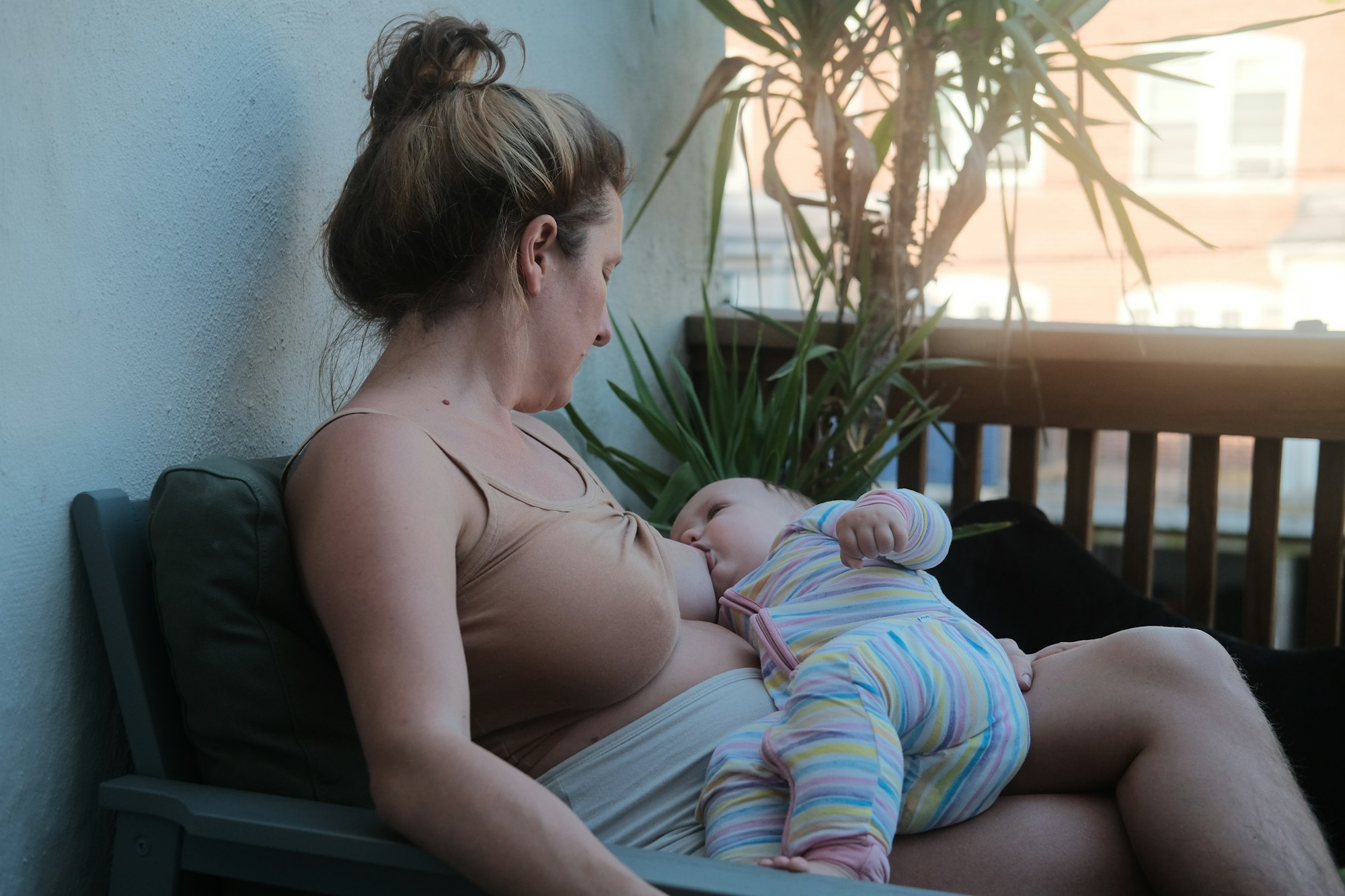Itchy Nipples While Breastfeeding - Causes and Natural Treatment
Itchy nipples while breastfeeding can be a common and uncomfortable problem for many women. This article will explore the causes of itchy nipples while breastfeeding and discuss treatment and home remedies.

In this article, we will explore the various causes of itchy nipples while breastfeeding and discuss treatment and home remedies that may help provide relief.
Cracked, Irritated Skin
Itchy nipples while breastfeeding are often caused by dry, cracked, or irritated skin on the nipples. This may be due to the sensitivity of the nipple tissue, particularly during the early weeks of breastfeeding, as the nipples adjust to a newborn's suckling. The symptoms should improve as the nipples become tougher, which can take anywhere from two weeks to two months.
Cracked, itchy nipples can be particularly common in those who have a history of skin problems. Women who have had eczema in the past may also develop eczema on their nipples due to the irritation of nursing.
To help prevent cracked, irritated skin on the nipples while breastfeeding, it is important to keep the nipples moisturized and avoid using soaps or other products that may be harsh or drying.
Using a lanolin-based nipple cream can help to protect and moisturize the skin, and wearing a bra with soft, breathable fabric can help to keep the breasts and nipples comfortable. It is also important to ensure that the baby has a good latch and is positioned properly during breastfeeding to minimize irritation.
Mastitis
Mastitis is a condition that is characterized by inflammation and pain in the deep breast tissue, typically caused by bacteria. It can appear suddenly, often during the early weeks of breastfeeding, and can cause itching and pain on the skin and within the breast tissue.
Some women may experience painful shooting sensations, and the breasts may feel warm to the touch. Mastitis can also cause a high fever. A common symptom of mastitis is a hard, red, and painful area in the breast, and the affected breast may feel warm to the touch. Other symptoms may include fatigue, muscle aches, and flu-like symptoms. Mastitis is more likely to occur in women who are experiencing engorgement or have a blocked milk duct, so it is important to address these issues promptly to help prevent the development of mastitis.
A doctor will usually prescribe antibiotics to treat mastitis, and it is important to seek medical attention as soon as possible because, in rare cases, an untreated infection can spread and become life-threatening. In addition to taking the prescribed antibiotics, it is important to continue breastfeeding or pumping to help clear the infection and prevent the development of a breast abscess. Applying warm compresses to the affected breast and taking over-the-counter pain medication can also help to reduce discomfort and swelling.

The Tushbaby Hip Carrier
With its ergonomic design and comfortable waistband, Tushbaby provides optimal support for you and your baby. Say goodbye to shoulder and back pain from traditional carriers, as Tushbaby evenly distributes your baby's weight, relieving strain and promoting better posture.
Thrush
Thrush is a type of yeast infection that can affect the nipples or breasts of breastfeeding women. It is a common condition that can cause itching and pain on the nipples and deep within the breasts. It can be difficult to identify the source of the pain, and it may change or worsen over time.
Thrush thrives in warm, moist environments, such as a baby's mouth, and the mother and baby can pass thrush back and forth for an extended period of time.
Symptoms of thrush in the breasts may include itching, burning, or shooting pain in the breasts, as well as redness, soreness, or a rash on the nipples. The nipples may also appear shiny or flaky, and the breast milk may appear thin or discolored.
Thrush can also cause a white, patchy, or shiny coating on the inside of the baby's mouth and on the tongue, as well as a diaper rash. A doctor will often prescribe treatment for both the woman and baby to help prevent thrush from recurring. This may include antifungal medication such as a cream, ointment, or oral tablet, as well as hygiene measures such as washing hands frequently and sterilizing pacifiers, bottles, and breast pump parts. It is important to follow the prescribed treatment and to complete the full course of medication to help prevent the recurrence of thrush.
Contact Dermatitis
Contact dermatitis is a type of skin irritation that occurs when the skin comes into contact with a substance that it is sensitive or allergic to. This can cause itching, redness, and a rash on the skin, and it may also affect the nipples and breasts while breastfeeding.
Contact dermatitis can be caused by a variety of substances, such as certain soaps, detergents, or lotions, and it can also be triggered by certain materials, such as the fabric of a bra or breastfeeding pad.
To help prevent contact dermatitis while breastfeeding, it is important to avoid using harsh or fragranced products on the breasts and nipples and to choose breastfeeding pads and bras made from natural, breathable materials.
If you suspect that contact dermatitis may be causing your itchy nipples, it is important to identify and avoid the offending substance and to use a gentle, unscented moisturizer to help soothe the skin.

Let-Down Reflex
The let-down reflex is the process by which milk is released from the breast during breastfeeding. It is triggered by the baby's sucking, which can cause a sensation of tingling or itching in the breasts, and this is normal, although not everybody feels a let-down. This sensation is usually temporary and should resolve once the milk has been released.
Bad Latch and Poor Positioning
A bad latch or poor positioning during breastfeeding can cause irritation and discomfort in the nipples and breasts. A poor latch occurs when the baby does not have a deep mouthful of breast tissue and is instead just sucking on the nipple. This can cause the nipple to become sore, cracked, or bruised and may also lead to a low milk supply.
To ensure a good latch, it is important to position your baby correctly at the breast and to support the breast with your hand to help guide them to the nipple. Your baby should have a mouthful of breast tissue, and the nipple should be positioned at the back of the mouth. It is also important to watch for swallowing and adjust the latch if necessary to ensure that the baby gets a good flow of milk.

Treatment and Home Remedies
There are a variety of treatments and home remedies that may help to provide relief from itchy nipples while breastfeeding. Some options include:
- Using a lanolin-based nipple cream to protect and moisturize the skin.
- Wearing a bra with soft, breathable fabric to help keep the breasts and nipples comfortable.
- Avoiding harsh or fragranced soaps, detergents, or lotions on the breasts and nipples. Try making your own gentle, natural breast milk soap.
- Using a breast pump to relieve engorgement and clear any blocked milk ducts.
- Taking over-the-counter pain medication, such as acetaminophen or ibuprofen, can help reduce discomfort and swelling.
It is important to avoid using any topical medication or home remedies without consulting a healthcare provider, as some substances may not be safe for use while breastfeeding.
When to See a Doctor
It is important to see a doctor if you are experiencing itchy nipples while breastfeeding and the symptoms are not improving or are accompanied by fever, fatigue, or flu-like symptoms.
It is also important to seek medical attention if you suspect that you or your baby may have an infection, such as thrush or mastitis. A lactation consultant or doctor who is knowledgeable about breastfeeding can help assess and diagnose the cause of itchy nipples and recommend appropriate treatment and home remedies. They can also provide guidance on caring for the breasts and nipples to help prevent future irritation.
References
- Mayo Clinic. (2021). Breastfeeding: Tips for preventing sore nipples. https://www.mayoclinic.org/healthy-lifestyle/infant-and-toddler-health/in-depth/breastfeeding/art-20047442
- Mayo Clinic. (2021). Mastitis. https://www.mayoclinic.org/diseases-conditions/mastitis/symptoms-causes/syc-20352687
- Mayo Clinic. (2021). Thrush (oral candidiasis). https://www.mayoclinic.org/diseases-conditions/thrush/symptoms-causes/syc-20378127
- Mayo Clinic. (2021). Contact dermatitis. https://www.mayoclinic.org/diseases-conditions/contact-dermatitis/symptoms-causes/syc-20353441
- American Pregnancy Association. (n.d.). Let-down reflex. https://www.americanpregnancy.org/breastfeeding/let-down-reflex/
- World Health Organization. (2018). Positioning and attachment - how to breastfeed.
